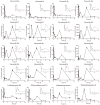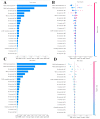Using Pharmacokinetic-Pharmacodynamic Modeling to Study the Main Active Substances of the Anticancer Effect in Mice from Panax ginseng- Ophiopogon japonicus
- PMID: 38257247
- PMCID: PMC10819458
- DOI: 10.3390/molecules29020334
Using Pharmacokinetic-Pharmacodynamic Modeling to Study the Main Active Substances of the Anticancer Effect in Mice from Panax ginseng- Ophiopogon japonicus
Abstract
Ginseng Radix et Rhizoma Rubra (Panax ginseng C.A. Mey, Hongshen, in Chinese) and Ophiopogonis Radix (Ophiopogon japonicus (L.f) Ker-Gawl., Maidong, in Chinese) are traditional Chinese herbal pairs, which were clinically employed to enhance the immune system of cancer patients. This study employed the pharmacokinetic and pharmacodynamic (PK-PD) spectrum-effect association model to investigate the antitumor active substances of P. ginseng and O. japonicus (PG-OJ). The metabolic processes of 20 major bioactive components were analyzed using Ultra-Performance Liquid Chromatography-Mass Spectrometry/Mass Spectrometry (UPLC-MS/MS) in the lung tissue of tumor-bearing mice treated with PG-OJ. The ELISA method was employed to detect the levels of TGF-β1, TNF-α, and IFN-γ in the lung tissue of mice at various time points, and to analyze their changes after drug administration. The results showed that all components presented a multiple peaks absorption pattern within 0.083 to 24 h post-drug administration. The tumor inhibition rate of tumor and repair rate of IFN-γ, TNF-α, and TGF-β1 all increased, indicating a positive therapeutic effect of PG-OJ on A549 tumor-bearing mice. Finally, a PK-PD model based on the GBDT algorithm was developed for the first time to speculate that Methylophiopogonanone A, Methylophiopogonanone B, Ginsenoside Rb1, and Notoginsenoside R1 are the main active components in PG-OJ for lung cancer treatment.
Keywords: PK–PD modeling; Panax ginseng–Ophiopogon japonicus; UPLC–MS/MS; lung cancer; main active substances.
Conflict of interest statement
The authors declare no conflicts of interest.
Figures




Similar articles
-
Comparative analysis of active ingredients and effects of the combination of Panax ginseng and Ophiopogon japonicus at different proportions on chemotherapy-induced myelosuppression mouse.Food Funct. 2019 Mar 20;10(3):1563-1570. doi: 10.1039/c8fo02354a. Food Funct. 2019. PMID: 30806385
-
Polysaccharide deriving from Ophiopogonis Radix promotes metabolism of ginsenosides in the present of human gut microbiota based on UPLC-MS/MS assay.J Pharm Biomed Anal. 2019 Oct 25;175:112779. doi: 10.1016/j.jpba.2019.112779. Epub 2019 Jul 17. J Pharm Biomed Anal. 2019. PMID: 31349212
-
Interaction of the main active components in Shengmai formula mediated by organic anion transporter 1 (OAT1).J Ethnopharmacol. 2022 Oct 5;296:115515. doi: 10.1016/j.jep.2022.115515. Epub 2022 Jun 28. J Ethnopharmacol. 2022. PMID: 35777609
-
Ophiopogon japonicus--A phytochemical, ethnomedicinal and pharmacological review.J Ethnopharmacol. 2016 Apr 2;181:193-213. doi: 10.1016/j.jep.2016.01.037. Epub 2016 Jan 27. J Ethnopharmacol. 2016. PMID: 26826325 Review.
-
Ophiopogon japonicus and its active compounds: A review of potential anticancer effects and underlying mechanisms.Phytomedicine. 2023 May;113:154718. doi: 10.1016/j.phymed.2023.154718. Epub 2023 Feb 16. Phytomedicine. 2023. PMID: 36854203 Review.
Cited by
-
Integrative metabolomics and transcriptomics profiling reveals differential expression of flavonoid synthesis in Ophiopogon japonicus (L. f.) Ker-Gawl. in adaptation to drought.PLoS One. 2025 Jan 7;20(1):e0313580. doi: 10.1371/journal.pone.0313580. eCollection 2025. PLoS One. 2025. PMID: 39774546 Free PMC article.
-
A Pharmacokinetic-Pharmacodynamic Study of Protosappanoside D, a Component Derived from Biancaea decapetala Extracts, for Its Anti-Inflammatory Effects.Int J Mol Sci. 2025 Apr 14;26(8):3694. doi: 10.3390/ijms26083694. Int J Mol Sci. 2025. PMID: 40332334 Free PMC article.
References
-
- National Commission of Chinese Pharmacopoeia . Pharmacopoeia of the People’s Republic of China. 11th ed. Chemical Industry Press; Beijing, China: 2020.
MeSH terms
Substances
Grants and funding
LinkOut - more resources
Full Text Sources
Medical
Miscellaneous

